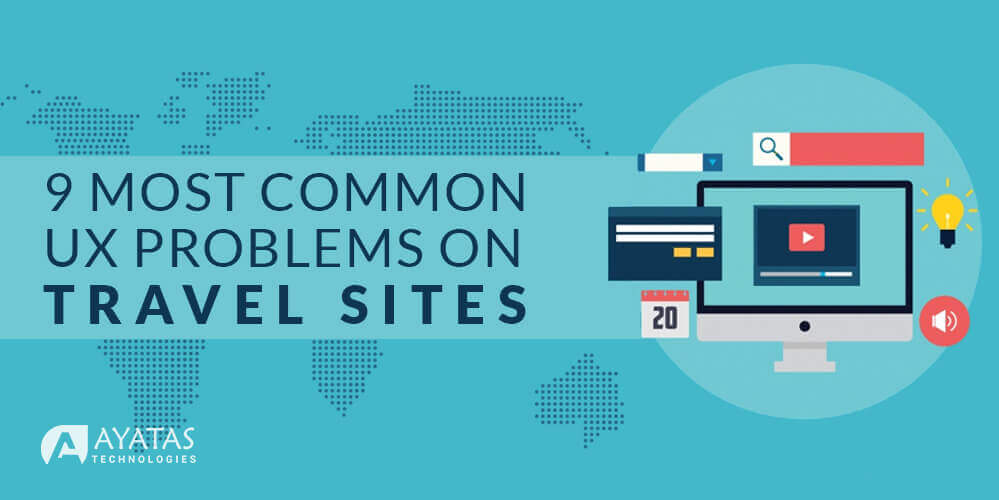
9 Most Common UX Problems On Travel Sites
When gathering data and booking travel, brands leverage UX to impart an effective brand experience. With UX as the new brand, we compiled the most common UX problems on travel sites.
1. Cluttered Layouts
A few websites overload their consumer with too much data resulting in a heavy cognitive load. Sure, the landing web page is prime real estate and it is tempting to squeeze special offers and product offerings on the landing page. keeping it simply lets the user focus on the task handy.
At the landing web page, the user is greeted simple layout that focusses at the search bar with a clear call-to-action. As soon as the user starts typing, the web page changes to an extra dynamic search page. Sites understand their clients’ targets and provide them with a clear and clutter-free search experience.
2. Unintuitive Fields
A drop-down menu for the destination, particularly when most of the text is obscured, slows down the search notably. If enter values or destinations are limited, a hybrid text box and drop down menu works great. During exploratory sessions, customers may also conduct several searches at a time and may be slowed down by drop-down menus.
Autocomplete search not only helps the consumer execute a search quickly but also can guide customers who want to explore options in a particular country rather than a city.
3. Easy Navigation
Progress Tracker
Progress tracker that informs the consumer in which they’re in the buying process, what’s to come and drives customers to search for completion. This feature is a should-have for airlines and helps to logically structure the booking process.
Interactive Map
An interactive map gives users a dynamic technique of searching. Maps that refresh the search parameters based on geography or destination-based pricing also can be a source of concept for travelers.
4. Not Customized For The User
TripAdvisor offers customers the option to select their currency and language. Unlinking the two offers a certainly customisable consumer experience.
New Site Visitors vs. Returning Site Visitors
When new site visitors land on your page, recommendations, and popular locations are ideal for creating inspiration if they’re not set on where to head.
However, returning site visitors must be greeted with recently regarded or lately searched offers that give them a more personalized experience. Returning users are 2x more likely to purchase during a session, hence the importance of personalizing the page.
5. Selecting a Date Is Tedious
Smart Calendars
Locating the best deal on flights can be a long procedure and may be difficult while the prices are so volatile. Skyscanner makes researching easy based on the certainty of the customers.
If a purchaser has specific travel dates, choosing the date is easy on the calendar. An essential UX point is to include the days from the previous and following month.
If dates are flexible, Skyscanner offers the choice of selecting the month, even the cheapest month.
6. Neglecting Mobile UX
Optimising your content across all devices have to be popular in 2016. Users are likely to conduct a few portion of their research on mobile. Although the sessions can be shorter, users want so that you can find data quickly.
HotelTonight is geared towards the spontaneity of booking last minute hotel deals. With this in mind, they optimised their mobile website with UX best practices which include larger buttons and ensuring that the credit card input field prompts the number pad.
7. Ignoring The Power Of Copywriting
Copywriting is regularly an afterthought in UX. Reassuring language can assist ease anxiety about the booking. Also, giving customers contextual data, such as limited inventory or other clients, nudges them to purchase. A superb example is seen on booking.com:
Clients often open multiple tabs or “page park” while searching for a great deal. When a user switches back and forth between tabs, the identity of the web page changes to the price. A minute detail like this that transforms and expedites the invention method helps the user to purchase faster.
8. User Inspiration
In general, e-commerce websites with clean, efficient designs to promote professionalism and win the client’s believe. But, the differentiating factor for purchasing your client to purchase rests at the brand’s ability to inspire wanderlust.
High-Impact Photos
Onefinestay uses large, high-res photos with plenty of light and makes the rooms look spacious and inviting. High-impact pictures evoke emotions with the user and draw the user in visually.
Wishlists
When studying for an upcoming holiday, clients often gather as many options as possible. The wishlist feature on AirBnB is simple to use and may be shared with travelling companions or your brand’s community-at-huge.
9. Not Including Reviews
In the search listings page, hotels.com not only included TripAdvisor reviews with their own client opinions however also highlighted listings that have been preferred by other users. Social proof is an essential driver to purchase.
Conclusion
Travelers’ needs are continuously evolving. Travel brands need to locate the proper combination of user-focused functionality with inspirational content. The customer purchase journey is a long process and the journey sector is highly competitive. Through providing a pleasant and efficient user experience, travel brands can compete on other factors other than price and drive customer loyalty.
For more information about your Web Design Solutions or for a free consultation: Call us at +1 (916) 936-8099 or fill out our online contact form to get in touch with our team.



